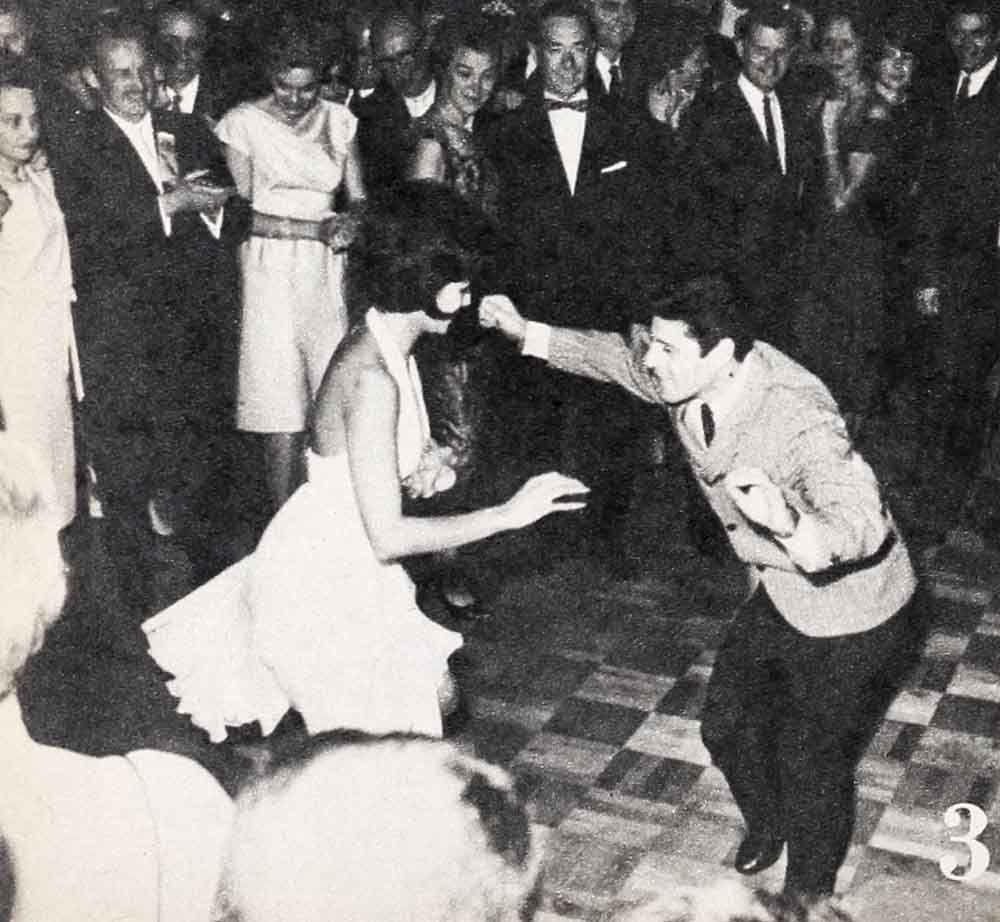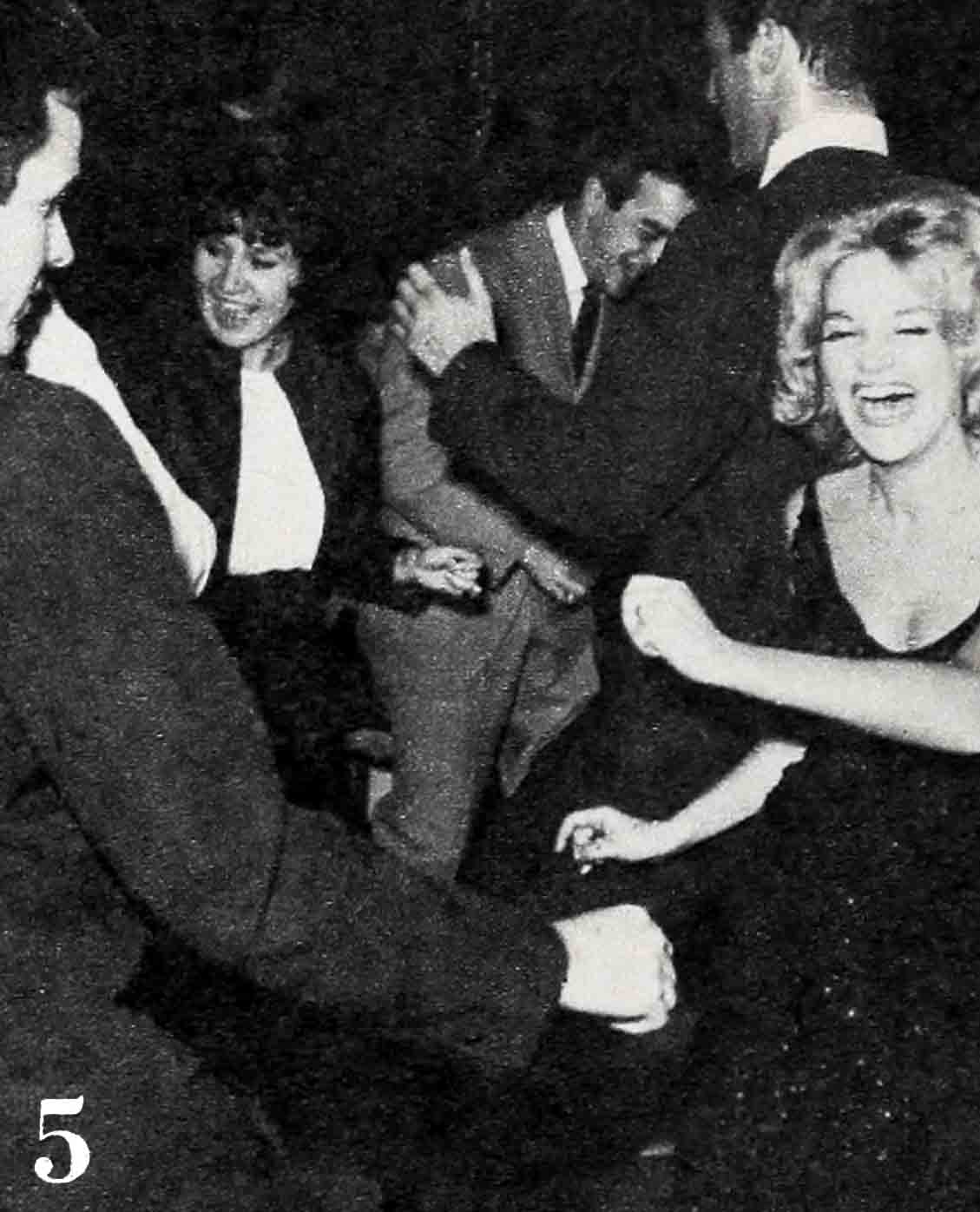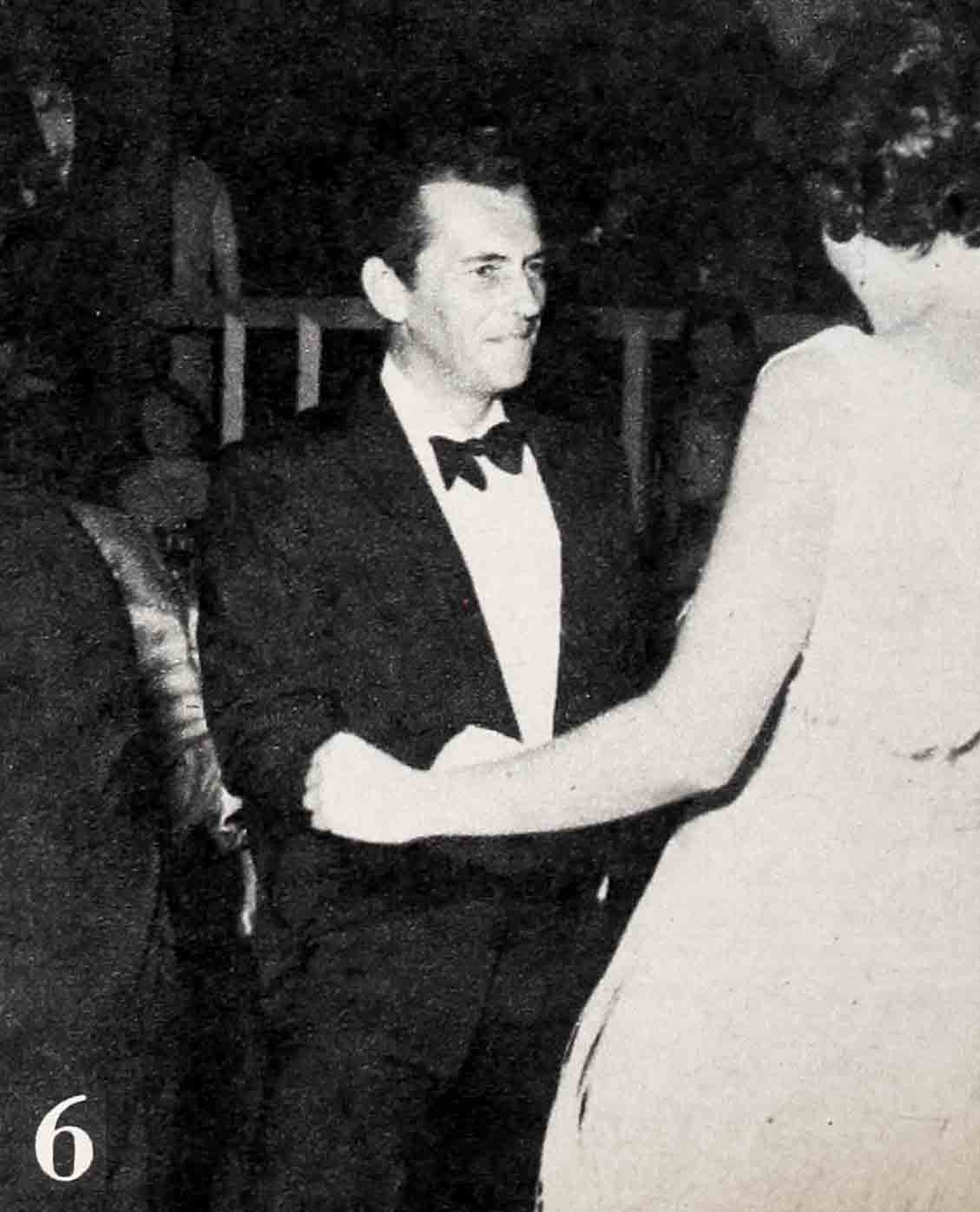
“Movement” That’s Danced To The Tune Of Rock ’n’ Roll Music
Dance crazes have swept the country before. But this one, daddy-o—it’s simply the most. It’s the twist. What is this madness which has titillated and hypnotized and conquered America—from the well-heeled aristocrats to the bourgeoisie and beatniks? Perhaps the best description is Arthur Murray’s—that the twist is nothing more than the shimmy, except that instead of shaking from the hips up, a twister gyrates from the hips down. “It is,” he says, “foot-loose and fanny-free.” Other experts won’t even go so far as to say this new craze is a dance. They call it simply a “movement” that’s danced to the tune of rock ’n’ roll music.
Are you with it, Jackson? I mean, are you following closely?
Well, they can call it what they will. So far as I’m concerned, man, this is IT. This is the wildest. No other dance in all of history has girdled the globe with such supersonic speed. No dance before it has torn down all class barriers. It has captivated rich, poor, young and old. What’s more, it has shaken them all up together, as a visit to the Temple of Twist—the Peppermint Lounge—will readily reveal. For in this boite on New York City’s West 45th Street, you can find a leather-jacketed youth with a duck-tailed haircut and his Jane in Capri pants and tight sweater dancing this torso-bender right alongside a black-tied Social Registerite and his wife—or someone else’s wife—garbed in a shimmering lame evening gown.
What power does the twist have to bring these people from worlds apart under the same roof to dance this violent, back-breaking solo seizure?
Perhaps the answer should be left to the psycho-sociologists. As yet, they have not completed all the depth surveys and random samplings. But many experts who have already spoken say that the twist is a sign of the times—an explosion of freedom from the same emotional ammunition dump which let loose the Charleston in the Roaring Twenties, the big apple in the Thirties, jitterbugging in the Forties, and rock ’n’ roll in the Fifties. Some high priests of mass psychology who’ve watched the wild gyrations of the twist have dis- covered trends, bogeymen, hysteria, mass neurosis, and the leering specter of degradation under the nation’s bed.
But don’t forget that in the past, every generation was criticized for something. Can’t you imagine a Grand Dame almost swooning at the first sight of the revolutionary dance of her day—the minuet?
Significantly, the squares of any generation were never taken seriously before.
Should they now?
The Charleston, the big apple, jitterbugging, and even rock ’n’ roll failed to topple the pillars of the republic. What makes anyone think the twist is any more or less potent than its predecessors?
The wild wiggle is really wild, but it is not going to be the final catapult which will send us all cometing into destruction. If anything, it has been a shot in the arm for the nation’s dancehalls, night clubs. bands, combos and the manufacturers who’ve made special girdles for twisters, special dresses and slacks with fringes, twist toys, dolls, and even shoes!
The platter industry is waxing—like crazy—every song that’s written on the twist. Roulette Records rushed a Count Basie arrangement of “The Basie Twist” into production so quickly that two days from the time it was cut it was in the hands of the deejays, and two days later it was selling over the counter. The initial sales topped 15,000; after two weeks, sales hit more than 250.000. Roulette had its eye on an eventual 2.000,000 sale that would make it a golden disc twice over.
The twist craze has already gone Hollywood. Three films went into instant production. Paramount beat out the pack by shooting “Hey, Let’s Twist” on a fast schedule and low budget, right at the scene of the mania—the Peppermint Lounge. The film was out Christmas Week. It starred Joey Dee and his Starliters, who helped put the PL on the map. . . . Columbia’s “Twist Around the Clock” starred the “King of Twist”—Chubby Checker— who may or may not have started it all. Louis Prima produced the third, “Doin’ the Twist.”
Midst all the hullabaloo, there’s a simmering feud about who did start it—Chubby Checker, Hank Ballard or Fats Domino. Time is with Ballard. He wrote the song called “The Twist” and recorded it—actually a number of years ago—as a rock ’n’ roll number. But it did not really get off the ground until Chubby took hold, in the summer of 1960, and made his own record of it. He also did the dance named after the song. Fats Domino also whipped his roly-poly body into the frenzy of the twist and made like a real cat to convert a huge flock of the uninitiated to this craze.
Blame it on the Madison
Beneath it all, everyone is pretty well agreed that the dance is derived from one called the Madison, which was popular with teenagers in the Baltimore, Philadelphia and Washington areas. It first achieved recognition about two years ago.
And natch, the teenagers discovered it.
But some folks claim the twist is hardly a new dance. Elsa Maxwell, the portly party-giver, says, “I remember dancing to a similar rhythm in the 1920’s in Paris. The French imported it from Africa, but goodness knows how it came here so late. I hear people saying it is sexy, but of course it isn’t. It’s too tiring to be sexy.”
Miss Maxwell should know whereof she speaks. Not long after the Peppermint Lounge became the place, Elsa materialized on the dance floor and, as one observer noted, “performed something that somebody identified as something rather resembling the twist.”
Bandleader Vincent Lopez sides with those who believe the Madison is the twist’s prototype, but even he finds room for some doubt. “The twist,” says Lopez, “is a mixture of the shimmy, the hula, Charleston and rock ’n’ roll. It is totally unlike the pony, the Bristol stomp and the slop. Actually it goes hack to the shimmy.” He agrees with Arthur Murray.
But flame-haired singer Glory Kennedy, who has done an album of Civil War songs, says the twist dates back to Abe Lincoln’s time. One of the numbers she did in the album, “Cannonball Twirl,” is an “instrumental twist,” according to Glory. In fact her record company is so sure of their facts that they’ve released the platter as a single, in hopes it would ride the crest of the mania.
A clinical psychologist, Dr. Albert Ellis, has taken the twist even farther back in time. He says: “. . . the twist is a return to original African ceremonial dances. If it is, the Africans want no part of it—or rock ’n’ roll for that matter.” The Ghanaian Times in Ghana, commenting about such Western “cultures” seen in the city of Accra, declared. “It is peculiar. It is outlandish; it is voluptuous; it is weird withal. It is even against our culture. The masses like the sensational, we admit. But we should be alert enough to stop the sway of the lewd over our society.”
How about that, daddy-o?
Dr. Ellis also found the music is “monotonous, pounding and frenzied.” He said, “I should think dancing schools would lose their shirts. The basic step is too simple. Maybe they”ll add new steps to it and evolve something entirely new.”
“Not me,” replied Fred Astaire, turning thumbs down at his chain of dance studios around the country. “As far as we’re concerned, the twist is just a body gyration with no set technique to be taught.”
“I don’t think much of it either,” said Arthur Murray. But his studios went right ahead and offered lessons.
All this incredible popularity is owing to one society columnist, Igor Cassini, who writes under the name of “Cholly Knickerhocker” in the New York Journal American. Igor, as a point of information, is the brother of Oleg Cassini, the designer of Mrs. Jacqueline Kennedy’s wardrobe.
Arthur Murray’s definition of the TWIST: “Footloose and Fanny-free.”
That white-House twist
Which brings up, for the moment, a story in a previous issue of Photoplay on the then red hot issue of who, if anyone, had danced the twist at a White House party given by President Kennedy. It was impossible at the time to break through the curtain of silence raised by presidential press secretary Pierre Salinger, who denied anyone had grinded through this gyrating and syncopating social symptom of the Space Age.
But it has since been told—Oleg actually did the twist with Mrs. Philip Geyelin!
So there, Mr. Salinger.
Now back to Igor, whose name may someday go down in history alongside Columbus, Magellan and Vespucci. He wandered into the Peppermint Lounge one night last fail with a group of elite Broad- wayites, lured by the joint’s “absurd” name. It was—and still is—a hole-in-the-wall honky-tonk. The visitors found the place crammed with leather-jacketed drifters, high-powered dames in sweaters and toreador pants and a collection of bearded, ragged beatniks who didn’t come to that flesh spa for atmosphere—but brought the atmosphere with them.
Cassini’s party was fascinated by the sight—especially when Joey Dee and the Starliters began to beat it out. They watched the crowd invade the pigmysized dance floor and cut up in the strange series of wrenches and squirms that became celebrated as the twist. The whole scene, man, was alien to the distinguished visitors. But so exciting that Serge Obolensky, the socialite hotel tycoon, yanked himself up from his chair and joined the cats on the floor.
Next day Cassini wrote about Serge’s antics in his column, and before anyone knew it, the Peppermint Lounge was invaded by more socialites than a charity ball. A few more plugs in Cholly’s column and the joint—and the twist—had it made.
Anyone who was anyone went there. “Dahling,” tinkled a thousand voices over the city’s phones, “you simply must go to the Peppermint Lounge.”
That’s how the Duke and Duchess of Bedford found their way to the PL, as did Tennessee Williams, Noel Coward, Judy Garland and Billy Rose.
Want some more names?
Well, Natalie Wood was there with Warren Beatty.
Want another name?
See if you can guess. She’s red-headed. She’s of the Frank Sinatra Hollywood Rat Pack. She’s got a figure like, uh! And one of the above-named is her relative.
If you don’t know yet, read on and see what this vivacious sexpot did when Joey Dee’s combo rapped out that mad, mad, mad beat. She was at a table, sort of jumpin’ in her seat as the couples surged on to the dance floor.
Joey spotted her, jumped from the bandstand and toddled over to her table.
“Shall we try it?” he asked.
It got to her!
The babe’s eyes flashed with delight. “I dig you, buster,” she burst out. She leaped to her feet and in an instant they were in the center of the floor. The crowd, sensing something big, cleared a space. For ten minutes, pandemonium reigned as this Hollywood queen, her flashing red hair bouncing in rhythm, spun erotically in wiggles, shakes and shimmies. Her every movement, forward and backward, was a panoramic symphony in ecstasy.
Finally she pleaded. “No more. No more, please! I’ve had it!”
And Joey Dee took Warren Beatty’s sister back to her table.
Oh. how Shirley MacLaine can twist!
The big story about the twist is not so much how the teenagers, the grownups, the beatniks and the Hollywood personalities went to it like ducks to water, but the way the Social Register turned out for the dance. It was like the Roaring Twenties, when Mayfairites sneaked up to Harlem to drink bathtub gin and dance the Charleston. Only now, in the Mad Sixties, they were dancing the twist unabashedly out in the open.
What Igor Cassini did for the twist with New York society, Oleg Cassini did for Washington’s “400.” For no sooner had he been identified as the man who had flung his hips to the north, west, east and south, than the Capital’s elite promptly became enchanted officially by the new dance mania. Mrs. Herbert May, the Post-Toasties heiress, gave a party at once, and the famed Sidney of the Mayflower brought his musicians to the soiree to play twist music. The guest of honor, Diane Dow (Dede) Buchanan, debutante daughter of former U.S. Chief of Protocol Wiley Buchanan, endeared herself to the devotees of the twist by dancing it herself.
The fad then spread like wildfire to other fashionable surroundings. In no time the “400” were wiggling as madly as if they were trying to shake off a million biting ants that had crawled under their minks and tails.
At the fashionable Crescendo in Los Angeles, where only the veddy, veddy ultra-ultra congregate, the twist was done as if the socialites really had pantsful of ants. They devised a variation called the “back scratcher” in which the twisters stand back-to-back and gyrate as if they were scratching away the crawling ants. It was like crazy, man.
A twist on the twist
In San Francisco, they danced the twist with highball glasses on their heads! I tried, but couldn’t find out whether it was gin or rye.
Then there was seventy-one-year-old former Mayor William Hartsfield, who tossed a mean hip at a benefit soiree ball in Atlanta’s posh Piedmont Driving Club when he went out there and twisted. Not since Sherman hit town had there been anything so hot.
Society was literally out of joint.
But so was the rest of the populace. The twist had become a national—even international—rage. In Rome, where Elizabeth Taylor tossed a party for Kirk Douglas, a group of swivel-hipped guests got up and went through the scintillating motions of the dance.
Did Liz?
Honestly, everyone I’ve talked to over there insists she didn’t. But maybe this story will have a sequel in the next issue of Photoplay. Look at how that White House soiree was twisted up.
Twisted up, incidentally, is what a lot of people are, over the twist. To put it bluntly, there are those who think it stinks.
Take Geoffrey Holder, Trinidad-born dancer and painter who has played himself in a film made in Britain, “all Night Long.” Holder volunteered this observation on the mania: “It’s dishonest. It’s not a dance and it has become dirty. Not because it has to do with sex—everything does. But it’s not what it’s packaged. It’s synthetic sex turned into a sick spectator sport.
“Not because it’s vulgar. Real vulgarity is divine. But when people work at it, break their backs to act vulgar, it’s embarrassing. . . . You have to be pretty far gone to want to do it all night.”
Bob Considine, the columnist and roving world reporter for the Hearst newspapers, says: “The twist, which has turned a joint named the Peppermint Lounge into the worst ventilated and successful trap in town, is best described as resembling two persons—preferably of different sexes—conversing while toweling themselves dry after a shower.
“What makes it so preposterous is that they appear to be complete strangers to the institution of the bath.”
No doubt about it—not everyone is twist crazy. Nevertheless it has rolled over the country and made its impact on the seismographs with the force of a major earthquake. And its rumblings can still be heard as loud as ever.
It’s more than likely the twist will be around a while. It is an exciting stimulant and the response has been national and nearly total.
Dances have come and gone over the years. They’ve had their brief moments of glory, then vanished. A few have endured—the waltz, fox trot, Lindy and Charleston, among others.
They are the durable dances—just as I believe the twist has become an enduring social phenomenon.
Now, before you rush out on the dance floor, remember this: You can’t get kissed while doing the twist. (It’s against the rules to embrace your partner.) But those in the know tell me you can get something much better. A gal who can twist will have the eyes of every man in the room on her. A gal can get a new slim waistline and hipline (expert Chubby Checker is hardly “chubby” anymore). But most important of all, a gal who can twist can get a whole new stagline—all lined up and ready to twist! And after a twisting session, what’s there to twisting a guy around your little finger?
—GEORGE CARPOZI Jr.,
author of twistdom’s new book, “Let’s Twist.”
It is a quote. PHOTOPLAY MAGAZINE APRIL 1962














